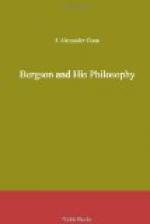Bergson then proceeds to state and to criticize some of the mischievous ideas which arise from Parallelism. There is the idea of a brain-soul, of a spot where the soul lives or where the brain thinks—which we have not quite abandoned since Descartes named the pineal gland as the seat of the soul. Then there is the false idea that all causality is mechanistic and that there is nothing in the universe which is not mathematically calculable. There is the confusion of representations and of things. There is the false notion that we may argue that if two wholes are bound together there must be an equivalent relation of the parts. Bergson points out in this connexion that the absence or the presence of a screw can stop a machine or keep it going, but the parts of the screw do not correspond to the parts of the machine. In his new introduction to Matiere et Memoire, he said, “There is a close connexion between a state of consciousness and the brain: this we do not dispute. But there is also a close connexion between a coat and the nail on which it hangs, for if the nail is pulled out the coat falls to the ground. Shall we say then that the shape of the nail gives us the shape of the coat or in any way corresponds to it? No more are we entitled to conclude because the psychical fact is hung on to a cerebral state that there is any parallelism between the two series psychical and physiological.” [Footnote: There must be an awkward misprint “physical” for “psychical” in the English translation, p. xi.] Our observation and experience, and science itself, strictly speaking, do not allow us to assert more than that there exists a certain correspondence between brain and consciousness. The psychical and the physical are inter-dependent but not parallel.
Bergson however has more to assert than merely the inadequacy and falsity of Parallelism or Epiphenomenalism. This last theory merely adds consciousness to physical facts as a kind of phosphorescent gleam, resembling, in Bergson’s words, a “streak of light following the movement of a match rubbed along a wall in the dark.” [Footnote: L’Ame et le Corps, pp. 12-13, in Le Materialisme actuel, or pp. 35-36 of L’Energie spirituelle (Mind-Energy).] He maintains, as against all this, the irreducibility of the mental, our utter inability to interpret consciousness in terms of anything else, the life of the soul being unique. He further claims that this psychical life is wider and richer than we commonly suppose. The brain is the organ of attention to life. What was said in regard to memory and the brain is applicable to all our mental life. The mind or soul is wider than the brain in every direction, and the brain’s activity corresponds to no more than an infinitesimal part of the activity of the mind. [Footnote: L’Ame et le Corps, Le Materialisme actuel, p. 45, L’Energie spirituelle, p. 61.] This is expressed more clearly in his Presidential Address to the British Society for Psychical Research




